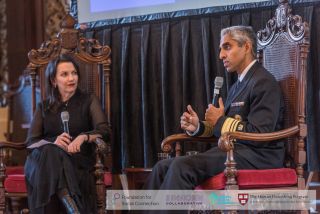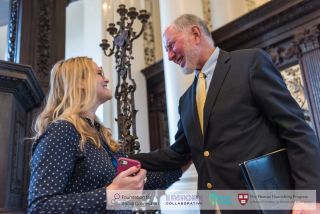Loneliness
Building Connected Communities
6 takeaways from Harvard’s forum for social connection.
Updated October 30, 2023 Reviewed by Devon Frye
Key points
- American adults say that having close friends is essential to living a fulfilling life.
- Social infrastructure in our cities and communities can foster connection.
- Clubs and associations tie us to local community and support.
- Being more present with others can foster connection.
According to a recent study by the Pew Research Center, 61 percent of American adults say that having close friends is essential to living a fulfilling life. And yet Americans appear to be declining in social connection across measures over time. This is showing up in reduced social engagement with friends, family, and others, reduced participation in civic activities, and elevated levels of loneliness. Recent studies have found that more than half of U.S. adults (58-61 percent) are considered lonely, with that number being especially high (79 percent) for adults aged 18-25.

When we consider that research shows loneliness and social isolation can be as bad for your health as smoking 15 cigarettes a day, we can understand the tsunami of concern making this a priority for our current U.S. Surgeon General, Dr. Vivek Murthy. Murthy had named this an “epidemic of loneliness and isolation,” and used his voice as an advocate for social connection, including at a recent forum on Building Connected Communities.
On a brisk fall day at the campus of Harvard University, I gathered with global and local leaders passionate about social connection for the Building Connected Communities action forum to work with leaders to address social isolation, loneliness, and connection. Below are a few of my top takeaways to help any individual or local leader make informed decisions to create social connections in their lives and communities.
1. The Good Life
If you’re like me, you’re curious: How do I live a good life? What career should I have, where should I live, how much money do I need, or how should I spend my time?
The Harvard Study of Adult Development is the longest-running study of these questions and what they find is clear—above all else, human connection matters.
- Focus on quality relationships with mutual vulnerability and joy.
- It pays in the long run to prioritize relationship building (friends and family) over major career successes.
- We need opportunities to be generous and matter in the community.
2. Intergenerational Bonds
Intergenerational bonds are one of the most important, yet missing, types of relationships in modern-day America.
- Intergenerational bonds can take many forms: biological grandparents, adopted family, neighbors, and local support networks.
- For families with children, these relationships help kids flourish and support the resilience of their parents.
- There are many benefits to being the one giving and the one receiving help. We all want to matter in the lives of others.
3. Full Presence
Our full presence—in both time and attention—is the greatest gift we have to share with the world. With it, we create and deepen relational bonds that carry us through life and create opportunities for empathy and compassion.
- Finding ways to be more present in the moment can help expand our perceptions of time with one another.
- Small cues in our environment—like a phone locker or bowl at the entry of the home—can help us be mindful of putting down our phones.
- Our voices carry with them emotional presence and levels of interaction much richer than text; whenever possible when communicating with loved ones from a distance, consider voice memos and messages.
4. Join In!
"Join, Or Die" was originally a call from Benjamin Franklin to the eight colonies that made up what he hoped would be the United States. The motto has now been resurrected in a documentary film that calls us to all join a club (service organization, church choirs, Rotary Clubs, etc.) and describes why the fate of America depends on it.

- From the women’s rights movement to the passing of civil rights legislation, successful changemakers throughout history were deeply rooted in clubs and organizations.
- A lack of participation in community clubs and service organizations weakens the social and civic fabric we rely on.
- Look for clubs that will help to tie you to issues you care most deeply about, and to your local community to form strong bonds of lasting support.
5. Authentic Being
One of the central things that has made me lonely throughout my life is the feeling of needing to fit in, rather than to be real. It’s a feeling often driven by a belief that we are not lovable or would not be accepted as we are. For many of us, our childhoods demonstrated that reality, and we decided to close around the wound to create a persona that others could more readily like.
- Showing up as ourselves helps give others permission to do the same.
- It takes great courage to be authentic with one another—ask for what we need, and show up fully—but this gives us the ability to be truly accepted, rather than just fitting in.
- Adapting to and having empathy for others is not mutually exclusive to being ourselves, it opens space up for communication and mutual understanding.
6. Places of Connection
Oftentimes, the design of the built environment is overlooked when we talk about social connection, and yet it is critically important to creating connected communities; this was something discussed at the forum by mayors, researchers, and policymakers alike. Our built environment from architecture, to urban planning, interior design and everything in between— shapes our opportunities for connection and can impact our loneliness.

- Social infrastructure, or spaces (parks, cafes, retail, streets and libraries) can help to support social health.
- The built environment can help foster social opportunities to cross-pollinate with others from different socioeconomic statuses than us, or our family of origin, this is essential for economic and social mobility.
- Social infrastructure is a form of climate resilience. As we respond to climate change with infrastructure investments, we should invest wisely in a future where we not only survive storm surges but where we take care of one another in moments of crisis.
Leaving Harvard University’s campus, the leaves were changing colors and a cool breeze filled the air. I felt a spirit of renewal and a sense of hope. Even in the darkness of our daily struggles, there is a golden thread that ties us together and illuminates hope. It is through relationships that we transform—we have the possibility to transform ourselves, transform one another, and create communities where every living thing can flourish.
What is one small thing you can do today to create connection wherever you are?




